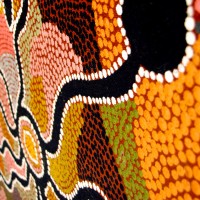Meditative Painting

Painting is the practice of applying paint or color to a surface, commonly with the use of a brush, but other objects can be used as well. In art, the term painting describes both the act as well as the result of the action.
Basic Difference between a Painting and a Sketch
The fundamental difference between a painting and a sketch is that a painting is led by colors, while a sketch is led by shapes. It is more linearly correct to attempt to paint first, before moving on to sketching, as color is primal to shape.
To illustrate this fact, let us take a new born baby as an example. The baby first begins to see colors; starting with black and white shades. It is only later that the baby begins to see and recognize shapes and forms.
Taking the above as a basic understanding, it can be seen ’incorrect’ to paint a painting that is led by shapes, as is popular in contemporary art, for this is actually a colorful sketch, as it is not led by color.
A Philosophical Point of View
The Western culture and society have a tendency to consolidate and formulate very quickly. Things are given shape and definition, pretty much as soon as possible. This habit establishes a feel of order and of being in control. Naturally, the tendency can also be seen in education, where children too are guided in this direction. Asking a small child “What do you want to do when you grow up?” or “What is your favorite food or color?”, and other such questions, help to establish a defining characteristic, develop a personality and establish specific likes and dislikes.
While it is completely natural that each person has personal preferences, as well as an ego, it seems that they are being emphasized and glorified. This attitude may seem supported and even beneficial, but it is actually based on a lack of trust or on excessive ambition.
On the other hand, cultures that are more receptive, in essence, have an indifferent approach towards one’s individuality; where personal preferences are minimized. This leaves room for change and growth, and also facilitates the ability to go beyond personal boundaries and limitations.
What does all this have to do with painting?
’Correct’ painting, so to say, can only happen or be expressed when the colors themselves are allowed to lead, letting specific shapes and themes arise from the color’s interaction. When the practitioner is neither imposing himself on the process, nor trying to take control, real art can take place.
As adults, this sort of work is not easy for us, as we are unfamiliar with being in a receptive state. Most likely, we have always been encouraged to be “pushy” and to give things direction. Painting in a receptive or a meditative way is really a process of surrender, of learning and of going into the unknown.










